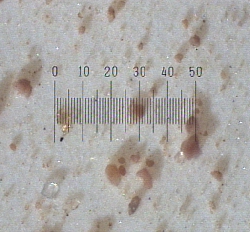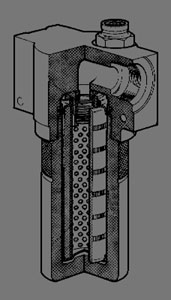
The Aircraft Porous Media Europe (APME) Division of Pall Europe Ltd is delighted to have the opportunity to supply high technology filtration systems (products) for the Rolls Royce re-heated Spey engine fuel system and for the hydraulic active suspension system.
All airborne and land-based equipment operating in a harsh environment, such as the Black Rock Desert or any other similar site which may be used for the supersonic land speed record, will rely heavily on filters to protect sensitive components.

In order that consideration was given to any possible problems caused by particles of desert dust finding their way into various systems on the car, the Pall Europe Scientific and Laboratory Services carried out an examination of a dust sample from the Black Rock Desert. The analysis examined and counted all particles larger than 2 microns in size and established that approximately 85% of the sample tested was smaller than 5 microns.
This analysis is fairly typical of a desert dust, which invariably comprises of particles of rock eroded through time, and made up of hard, irregular shaped particles which vary in size from less than 1 micron (0.00004 inches) to over 100 microns (0.004 inches).
Smaller sized particles would be particularly damaging to the components within the fluid systems of Thrust SSC as they are ingressed during normal operation. Very fine dust can work its way into almost any system and is then extremely difficult to prevent from getting in between the surfaces of adjacent moving components, as the oil film thickness is actually larger in most cases than these small particles.
The result of system contamination with desert dust leads to excessive and rapid component wear, inefficient running, overheating and, possibly, premature total failure.
Filters were selected which would provide the necessary protection to system components by capturing and holding any damaging particles which might enter the system.

The Spey engine main fuel filter protects fuel system components right through to the combustion chambers. The filter is rated at 30 microns absolute, which is the Rolls Royce specified requirement for this engine. This means that all particles larger than this size in the fuel are stopped by the filter as well as lesser numbers of smaller particles.
The active suspension system maintains the car's correct front-to-rear attitude. Any deviation from the car's normal attitude by the unintentional raising or lowering of the car's leading edge must be countered immediately by the active suspension which adjusts the angle of the car to maintain horizontal stability. It is essential that the active suspension system works with total reliability at all times.
The hydraulic system within the active suspension system contains a number of high-performance servo valves which are able to respond in milli-seconds to any signals that the active suspension system sends out in order to compensate for an incorrect attitude. These components are sensitive to contamination by particles in the hydraulic oil and require total protection at all times.
Once the active suspension system has been assembled and filled with hydraulic oil, it is necessary to thoroughly clean from the system any contaminant which was generated during assembly and accidentally introduced during filling. This is done by flushing the system with filters which are finer than those fitted for normal running.
It is normal to fit the servo valves after completion of the flushing exercise, dummy blocks having been installed in their place during the flushing.
Flushing is carried out using filters rated at 1 micron and having a filtration ratio (Beta) of 200. This rating is in accordance with current filtration technology and defines the ratio of the number of particles of the specified size (1 micron in this case) entering the filter to the number of the same sized particles exiting the filter. It is an indication of the efficiency of the filter.
Fluid samples are taken during the flushing exercise to establish when the fluid cleanliness has stabilised at the appropriate level. On completion of this phase, the servo valves are fitted and the normal service filter elements are installed into the filter housings.

The filter assemblies are designed to withstand a system pressure of 210 bar (3000 psi). No bypass valve is fitted to ensure that the hydraulic fluid always passes through the filter elements, which are also able to withstand full system differential pressure without structural collapse, thus ensuring the necessary protection to the complete system at all times.
The filter assemblies are fitted with visual indicators which show the condition of the filter elements. When the filter element is blocked to a differential pressure of 7 bar (101 psi) an indication is given that this condition has been reached and a new filter element should be fitted.
The effect on differential pressure of a blocking filter element is represented in the form of an exponential curve. After the figure of 7 bar has been reached the differential pressure starts to rise very rapidly and there is no appreciable life left in the filter.
The unique filter medium is a graded pore construction of inert, inorganic fibres impregnated and bonded with specifically formulated proprietary resins. The filter medium is fully supported both upstream and downstream to ensure pleat stability and guaranteed performance over all operating conditions.
APME will monitor the hydraulic fluid cleanliness during the lead up to the record attempt to ensure that the required levels are being achieved and maintained.
 |
 |
 |
||
| Sponsored by | This site best viewed with Microsoft Internet Explorer 3 | |||